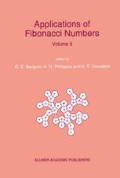Abstract
One of the easiest and best known ways to generate a self-similar fractal pattern is to view from an infinite distance the set of lattice points (m, k) for which (m k ) is odd. More generally, one can fix a prime p, and consider for a given exponent e ≥ 0, those lattice points (m, k) for which (m k ) is exactly divisible* by p e. When viewed from infinity (see Section IV for formal definitions), the resulting pattern Xe is usually not self-similar, but it does inherit important geometric properties from the “preceding” pattern Xe — 1
Access this chapter
Tax calculation will be finalised at checkout
Purchases are for personal use only
Preview
Unable to display preview. Download preview PDF.
References
Bondarenko, B., Generalized Pascal’s Triangles and Pyramids, Their Fractals, Graphs and Applications. (Published in Russian, Ed. Acad. Sci. Uzbekistan, Tashkent, 1980).
Carlitz, L., “The Number of Binomial Coefficients Divisible by a Fixed Power of a Prime.” Riv. Mat. Univ. Parma, Vol. 11.2 (1970): pp. 45–64.
Dodd, F. and Peele, R. “Some Counting Problems Involving the Multinomial Expansion.” Math. Mag., Vol. 64(1991): pp. 115–122.
Flath, D. and Peele, R., “A Carry Theorem for Rational Binomial Coefficients.” Applications of Fibonacci Numbers, Volume 4. Edited by G. E. Bergum, A.F. Horadam, and A.N. Philippou, (1991): pp. 109–120.
Flath, D. and Peele, R. “Fractal Patterns Derived from Rational Binomial Coefficients.” Applications of Fibonacci Numbers. Volume 5. Edited by G.E. Bergum, A.F. Horadam, and A.N. Philippou, (1993).
Falconer, K. The Geometry of Fractal Sets. Cambridge (1985).
Holte, J., “The Dimension of the Set of Multinomial Coefficinets Not Divisible by n.” Contributed talk (abstract #863-05-726), 863rd meeting of the American Mathematical Society, San Francisco, January 16–19, 1991.
Holte, J., “The Fractal Geometry of Multinomial Coefficients Not Divisible by n” MAA/NCS Summer Seminar presentation, Duluth MN, August 13, 1991.
Howard, F., “The Number of Multinomial Coefficients Divisible by a Fixed Power of a Prime.” Pacific J. Math., Vol. 50 (1974): pp. 99–108.
Howard, F. and Castevens, P., “The Density of q-Binomial Coefficints Divisible by an Arbitrary Integer.” Preprint.
Knuth, D. and Wilf, H., “The Power of a Prime that Divides a Generalized Binomial Coefficient.” J. Reine Angew. Math., Vol. 396 (1989): pp. 212–219.
Kummer, E., “Über die ergänzung Batze zu den allgemeinen reciprocitätsgestzen.” J. für Math., Vol. 44 (1852): pp. 115–116.
Peele, R., “Divisibility Patterns for Some Combinatorial Sequences.” Combinatorics ′88 Proceedings of the International Conference on Incidence Geometries and Combinatorial Structures (2nd volume) (1992): pp. 287–294.
Reiter, A. “Patterns in Pascal’s Triangle.” First Prize entry, Westinghouse Science Talent Search for 1990–91.
Singmaster, D., “Divisibility of Binomial and Multnomial Coefficients by Primes and Prime Powers.” 18th Anniversary Volume of the Fibonacci Association. The Fibonacci Association (1980): pp. 98–113.
Sved, M., “Divisibility-with Visibility.” Math. Intelligencer, Vol. 10 (1988): pp. 56–64.
Wolfram, S., “Geometry of Binomial Coefficients.” Amer. Math. Monthly, Vol. 91 (1984): pp. 566–569.
(added in proof) Haesler, F., Peitgen, H. and Skordev, G., “Pascal’s Triangle, Dynamical Systems.” Institut für Dynamische Systeme Report #250 (July 1991)
Editor information
Editors and Affiliations
Rights and permissions
Copyright information
© 1993 Springer Science+Business Media Dordrecht
About this chapter
Cite this chapter
Flath, D., Peele, R. (1993). Hausdorff Dimension in Pascal’s Triangle. In: Bergum, G.E., Philippou, A.N., Horadam, A.F. (eds) Applications of Fibonacci Numbers. Springer, Dordrecht. https://doi.org/10.1007/978-94-011-2058-6_22
Download citation
DOI: https://doi.org/10.1007/978-94-011-2058-6_22
Publisher Name: Springer, Dordrecht
Print ISBN: 978-94-010-4912-2
Online ISBN: 978-94-011-2058-6
eBook Packages: Springer Book Archive

